The Power of Santa Barbara’s P3
Inside Marcus Elliott’s Peak Performance Project, Where Pro Sports Stars Train in the Funk Zone
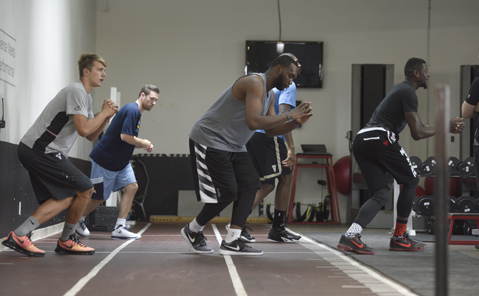
Kyle Korver and Al Jefferson are professional basketball players with a combined 23 years of experience in the NBA. During their careers, each of them has made a home in four different cities. Korver, a 6’7″ shooting guard, has moved from Philadelphia to Salt Lake City to Chicago to Atlanta; Jefferson, a 6’10” center, from Boston to Minnesota to Salt Lake City to Charlotte.
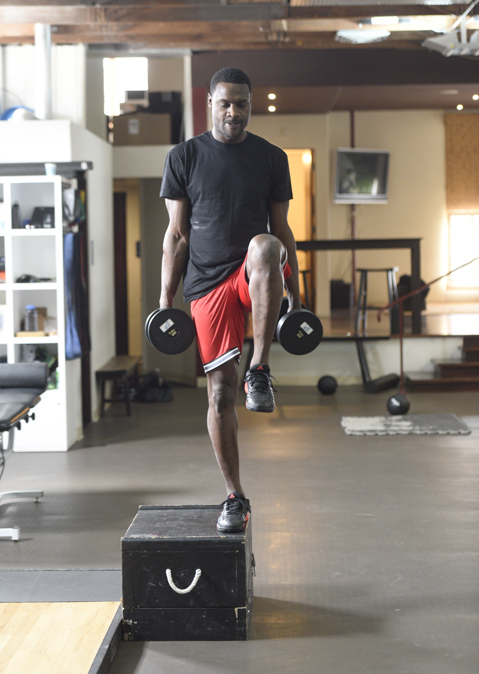
During the past six to eight summers, there’s just one place they’ve called home: Santa Barbara. Growing numbers of their NBA brethren have followed them here. The main attraction is not the weather, the beaches, or the smallish-town ambience. It is a nondescript building a few blocks from the beach, with a floor space the size of a basketball court, which houses the Peak Performance Project (P3), a high-tech laboratory for the testing and training of elite athletes.
P3 is the brainchild of Marcus Elliott, a graduate of Harvard Medical School who took his two interests, sports and science, and fused them in a new way. He looked at the specific skills and movements that certain sports require (primarily baseball, basketball, and football) and began analyzing how the bodies of players functioned, each in its own way. Instead of giving them cookie-cutter training programs, he was able to tailor exercises that address an individual’s specific strengths and weaknesses.
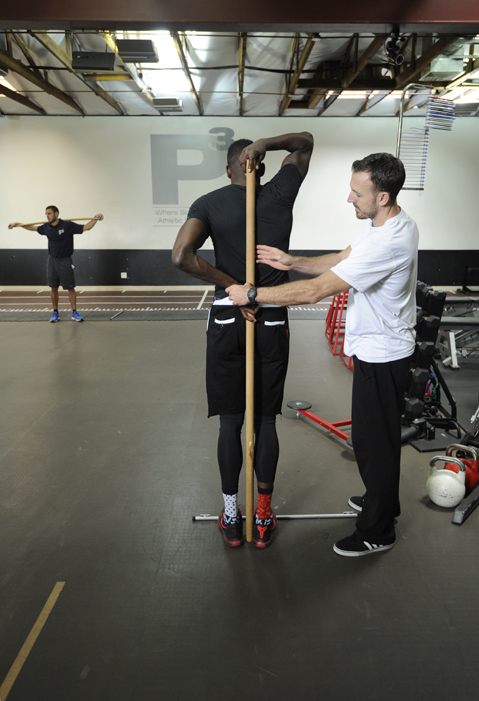
A lengthy article in Sports Illustrated last December explained how Elliott’s methods might help prolong careers by identifying areas of potential injury and taking steps to rectify them. By then, P3 was already on the map in the pro basketball world.
Korver and Jefferson both started visiting P3 when they were players with the Utah Jazz. Then-coach Jerry Sloan, now an adviser to the club, was enthusiastic about the off-season program. The Jazz continue to send their players here every year before training camp.
“I had a lot of issues going on physically, a really bad knee and some other things,” said Korver, who arrived at P3 in 2008. “I could feel myself getting better. I learned a lot about my body and how to take care of it, how to move more efficiently, how to move more healthily — if that’s a word. It was kind of a turning point for me. I started coming out here every summer. My wife and I bought a house here a couple years ago.”
The effort has paid dividends for Korver, 34, who was an NBA All-Star for the first time last season. He is a deadly long-range shooter who passed Kobe Bryant for 12th on the all-time three-pointers-made list in March.
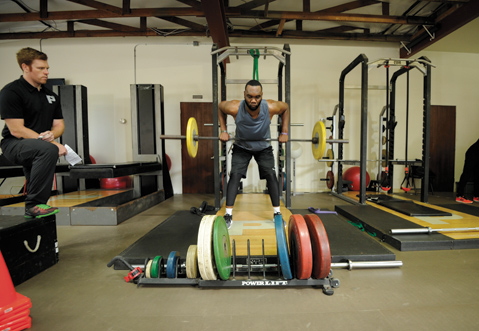
“I had a good year, and the team did well,” the Hawks guard said. “Our coach [Mike Budenholzer] is a great guy to play for. Every year you keep your group together, develop more chemistry, play in more play-off series — all those things add up to a better team.”
But going deep into the play-offs after an 82-game season makes for a long grind. “It’s brutal,” Korver said. “It takes a toll on your body. P3 prepares me for that. They won’t cut the number of games. They’d be cutting the money.”
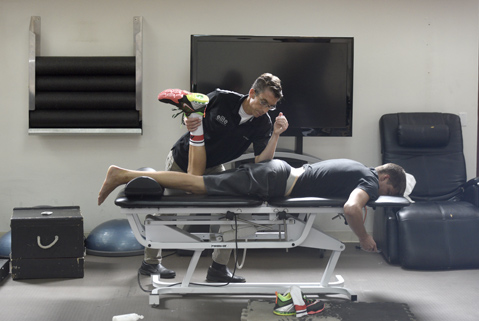
Innovative Idea
Elliott was thinking about the dollars pouring into pro sports leagues when he opened P3 in 2006. “It was like the emperor’s new clothes,” he said. “Doesn’t everybody else see what I see? Doesn’t it make sense to know more about this player that you’re paying $100 million to? Don’t you realize this guy is a complete unknown in terms of how his body works? It made no sense to me. We have tools we can use to get a better understanding of these systems.”
Despite that confidence, he wasn’t sure if it would work. “I thought this would be a damn fun thing to do, and I knew there would be a value for the people and the athletes we touched,” he explained. “From a business perspective, I had no idea what it could be or how much demand there would be. I still pinch myself a little bit. I’m still amazed. Part of it was the right timing, and part of it was having the conviction to do this stuff before other people did, to take a hard stand and invest in the technology and the smart personnel.”
The technology includes force plates embedded in the floor and 10 German-made cameras that capture in great detail a body in motion. “It’s the same technology [used to produce] video games,” said Stanford graduate Eric Leidersdorf, the lead bio-mechanist at P3, as he compiled masses of data on a computer screen.
Elliott added, “Moving here feels like one of the smarter things I’ve done. I originally felt like Santa Barbara could be a hindrance for focusing on pro athletes. There are no pro teams here. In the end, it’s actually been a positive. It’s a great retreat for the athletes.”
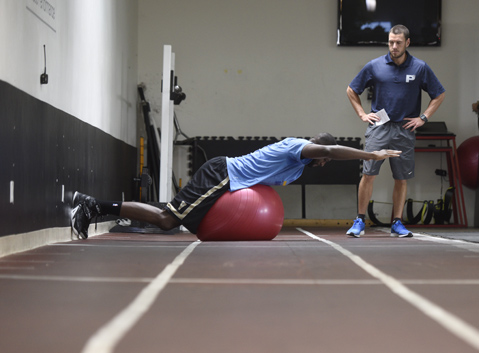
Santa Barbara Calling
Jefferson has come to P3 every year since 2010 in a love/hate frame of mind. “When you work so hard, you hate it, but you know it’s probably good for you,” said the Hornets center, who has steadily recovered from a 2009 ACL injury. “I can tell my knee is getting back to the way it was before. I gotta do what’s best for me.”
Jefferson was one of the last NBA players drafted out of high school, in 2004. He came from the small town of Prentiss, Mississippi. “I’m a country boy,” he said. “I’m not a big-city type of guy. Going from my hometown to Boston was, whoa, like going to Germany. I love Santa Barbara, man. It’s small and peaceful. I love to go by the beach. I love the seafood spots. The No. 1 reason is this place [P3], knowing I’m getting better to further my career. I’m only 30 years old. I got a lot more years to play.”
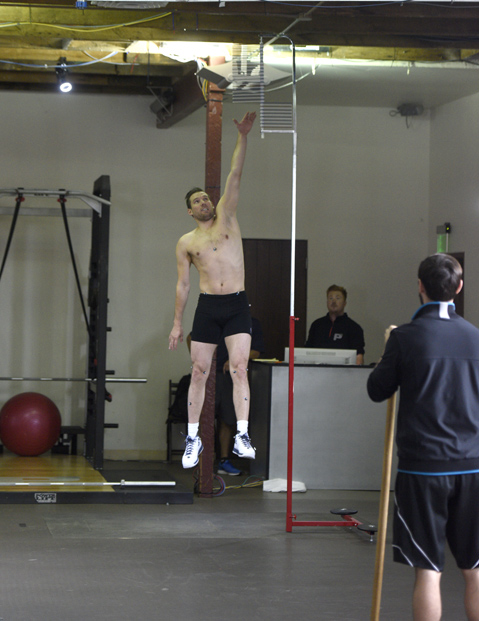
The word has gotten out. Korver and Jefferson found themselves in a lot of company this summer. “Every week, new guys show up,” Jefferson said. “I look around; there’s me, Joakim Noah, and Andre Drummond — three of the top centers in the league working out together. You can’t get that anywhere else. When the season starts, we step on the court and try to tear each other’s head off. This is the time everybody wants to go and get better as a player. We can do that together.”
P3’s training emphasizes movement, quickness, and agility. It runs counter to the notion that stronger is better. “Originally the performance coaches were called strength coaches,” Elliott said. “Literally that’s what they did. They got guys to move weights around. … But you don’t necessarily want guys who are stronger; you want athletes to move better. It’s really easy to take an athlete and make him a lot stronger — he benches more, he squats more — and then he jumps slower, and maybe he doesn’t jump as high, and maybe he’s a lot slower laterally, and his hips are so immobile he can’t put himself in these athletic positions any more. You can make them a lot worse as they get stronger.”
Baseball is another sport where the P3 approach is borne out. Former major leaguer Lou Piniella, who was on the disabled list twice in 18 seasons, recently told the New York Daily News: “When I played, we didn’t have a weight room or a strength coach …. We never heard of an ‘oblique.’ … [W]e were in shape to play baseball. Baseball is a game of fluidity, timing and coordination. It’s not a game of muscle mass.” Injury prevention is a cloudier prospect in football, where the nature of the sport produces forceful collisions.
Adam Hewitt, P3’s assistant general manager, noted that the facility’s NBA clients maintain a work ethic that makes them pros for the long term. “They have to be committed to make the trip out here,” he said. “Carmelo Anthony took three flights to get here.” Hewitt added, “Santa Barbara is a little quiet for the younger guys,” who might be looking for action outside the training room.
One of the younger guys who made himself at home for several weeks was Thomas Robinson, a 6’10” power forward who was recently acquired by the Brooklyn Nets. He bought a bicycle to transport himself around town. “I’m here strictly for work,” said Robinson, 24. “I’m not looking for fun. It’s good to learn these things early in your career.”
The players do say that the city’s a good place for relaxing in between workout sessions. “Almost all of them are comfortable taking a low-key approach,” Elliott said. “Aside from the fact many are almost seven feet tall and black, they look like Santa Barbara locals. People see them walking around town wearing flip-flops and board shorts.”
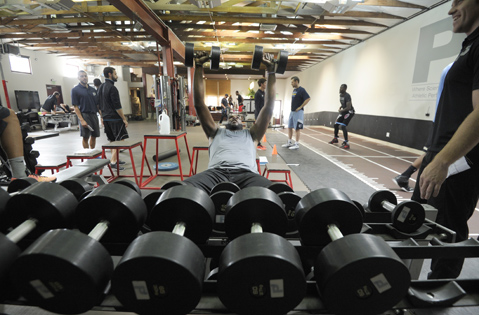
It’s the Players’ Ball
At the behest of the NBA, Elliott and his team of specialists have tested prospects at the predraft combines in Chicago each of the last two years. They tested 55 of the 60 selected players before the 2015 draft, and three of the top 10 — Jahlil Okafor (No. 3 pick, 76ers), Stanley Johnson (No. 8, Pistons), and Frank Kaminsky (No. 9, Hornets) — spent some time in Santa Barbara.
“The NBA needs to be supersmart,” Elliott said. “As opposed to football or baseball, when one player goes down, it completely changes the dynamic of your team. A team can’t lose a rotation player and not lose a beat; in other sports they can. Six to eight players are critical to an NBA team. They’re investing a whole lot in being the smartest professional sport.”
There have been extensive conversations over who should assume custody of the assessments made by P3. Elliott decided that the players should receive the results of this year’s tests.
“Is it performance data, or is it medical data?” Elliott said. “Is this measuring a vertical jump, or is this more like measuring somebody’s cholesterol level? I would make the case it’s more like measuring cholesterol. Doctor-patient seems like the right model. That’s where it’s going to go.”
Elliott believes that players’ bodies “are their most prized possessions.” He explained, “It doesn’t matter if you’re under contract to the Lakers. It’s not their body; it’s your body. If the players are smart, they’ll share the data with the teams to direct their training programs, but they shouldn’t have to. We’re going to give the combined results to the players by September 15. Every player going into the NBA is going to get a biometric sheet from us, showing all their strengths and weaknesses, showing where they’re most at risk in terms of injury and solutions for those. It goes only to the players. They can share it with their organization, they can share it with their agent, or they can just keep it or throw it out. I like the idea of putting that power back in their hands.”
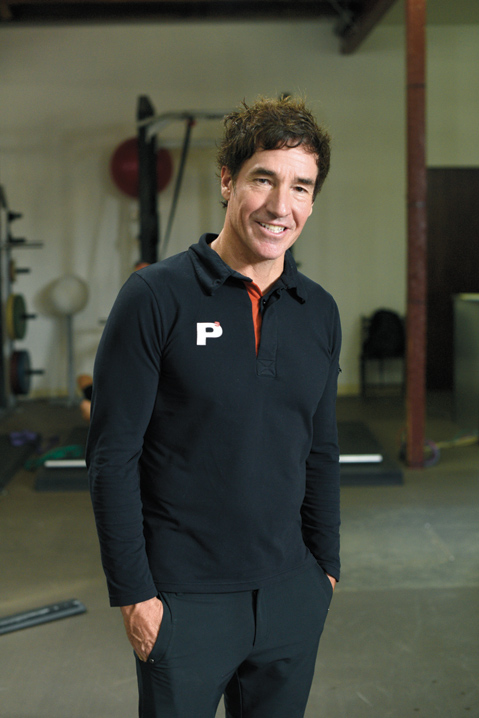
Elliott cannot promise that a player will be injury-free. Korver and Jefferson both suffered strains and sprains last season. “If we look at our NBA injury database, there’s a lot of ankle injuries in there,” the P3 director said. “But guys are missing less than a couple weeks, and they don’t recur. We can deal with that amount of randomness. Almost all the serious injuries are as a result of having a system that’s out of balance or some type of movement issue. Those are injuries that are telegraphing themselves before they manifest.”
Creating a sound body in the training room breeds a sound, keen mind. “Take Andre Drummond,” Elliott said of the Detroit Pistons center. “He can’t wait for the season to start. He just wants to go crush people. He spent six weeks sweating and bleeding every day. He wants to show people the systems he has. If guys have that confidence, that it’s bulletproof, it goes so far in terms of their competitive spirit and what they’re willing to put on the line.”



